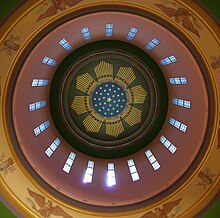Frank Henry Schwarz (21 June 1894 – 5 September 1951) was an American painter and muralist.
Frank H. Schwarz | |
|---|---|
 Franz Schwarz in the early 1920s | |
| Born | June 21, 1894 New York City |
| Died | September 5, 1951 (aged 57) Mount Vernon, New York |
| Nationality | American |
| Known for | Painter and muralist |
| Awards | Rome Prize |

Biography
editSchwarz was born in New York City on 21 June 1894.[1] Later Schwarz's family lived in Chicago, Illinois.[2] When Schwarz's mother died, his father, Frank, returned to New York City, but Schwarz stayed in Chicago to continue his studies at an art school there.[2] Later he served in the Army.[2]
In 1921, he was awarded a fellowship in painting, the Rome Prize, from the American Academy in Rome for his work "Heroism".[2] The prize not only saved an ill Schwarz from eviction, it also allowed him to reunite with his father, who had lost touch with him for six years.[2]
Schwarz became a Guggenheim Fellow in Fine Arts in 1926.[3]
In 1929, the Brooklyn Museum purchased Schwarz's work "Lugietta".[4]
Several of Schwarz's murals decorate the 1938 Oregon State Capitol, including two large ones in the rotunda, one depicting Lewis and Clark at Celilo Falls,[5] and one depicting an 1843 wagon train: "On the Oregon Trail".[6] Another of his murals is in the Senate chamber behind the Presidents's desk, "Bringing the News to Salem March 17, 1859", depicts the announcement of Oregon's statehood.[7] Schwarz and the capitol's other muralist, Barry Faulkner, painted their murals at Schwarz's New York studio where they could compare color and highlighting.[8] The artists traveled to Oregon to supervise the installation of their work.[8] Schwarz also painted the interior of the rotunda's cupola.[9]
Other works by Schwarz include the six icons above the main altar and the Stations of the Cross at the Church of the Ascension of Our Lord in Westmount, Quebec, Canada,[10] and an altar triptych, "The Adoration of the Peasants", in the Island Chapel at Nazareth Hall Preparatory Seminary in Saint Paul, Minnesota.[11] The altarpiece was removed from the chapel when Nazareth Hall was sold to Northwestern College in 1970.[11]
Schwarz was a life member of the National Arts Club.[1]
He died in Mount Vernon, New York on 5 September 1951.[1]
References
edit- ^ a b c Lowrey, Carol (2008). A Legacy of Art: Paintings and Sculptures by Artist Life Members of the National Arts Club. Hudson Hills Press. pp. 174, 209. ISBN 978-0-615-15499-2.
- ^ a b c d e "Painter Facing Eviction When Painting Wins Prix de Rome". The New York Times. June 29, 1921. Retrieved 2009-10-23.
- ^ "Frank Henry Schwarz". John Simon Guggenheim Memorial Foundation. Archived from the original on 2011-06-04. Retrieved 2009-10-23.
- ^ "Napoleonic Relics, Gift of Marion Reilly" (Press release). Brooklyn Museum. c. 1929. Retrieved 2009-10-23.
- ^ Cutright, Paul Russell (2000). A History of the Lewis and Clark Journals. University of Oklahoma Press. p. 236. ISBN 0-8061-3247-7.
- ^ "Murals of Oregon Embellish Its New Capitol". Life. August 13, 1939. p. 45.
- ^ "Senate Chamber Mural". Oregon State Legislature Secretary of the Senate. Retrieved March 19, 2014.
- ^ a b Applegate, Richard (December 22, 1938). "Oregon's History is Reviewed in State Capital Murals". The Register-Guard. Retrieved 2009-10-23. [dead link]
- ^ "Oregon State Capitol Tour: Rotunda". Oregon Legislative Assembly. Archived from the original on 2009-10-30. Retrieved 2009-10-23.
- ^ "The History of Ascension of Our Lord Parish". Ascension of Our Lord Parish. Archived from the original on 2010-02-02. Retrieved 2009-10-23.
- ^ a b "Shrine Chapel". Northwestern College. Archived from the original on 2008-06-15. Retrieved 2009-10-23.
External links
edit- Frank Schwarz at Askart.com
- Black and white images of Faulkner's and Schwarz's capitol murals from Salem Public Library (includes an image of the artists)
- Image of the mural in the Oregon Senate chambers